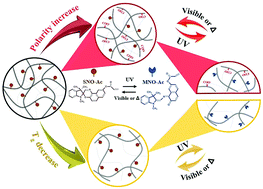Spectral and kinetic manifestations of chain flexibility and polarity in the reversible photoisomerization of spironaphthoxazine-based acrylic copolymers†
Abstract
Future advances in photoresponsive materials essentially depend on our knowledge about how the substrates, and typically their Tg and polarity, affect their photochromic properties. These have been followed in two separate sections. First, copolymers of methyl methacrylate (MMA), spironaphthoxazine ethyl acrylate (SNO-Ac) and ethyl acrylate (EA) with various Tg values and similar polarities were prepared through miniemulsion polymerization. Next, copolymers of MMA, SNO-Ac and acrylic acid (AA) with various polarities and identical Tg values were prepared via solution polymerization. The products were comprehensively characterized by DLS, DSC, SEM and UV-Vis analyses. Size and morphology analyses for the first series of latexes confirmed the existence of particles in the range of 80–100 nm, providing their efficient interaction with the illuminated UV and visible lights. It was found that the photoactivity of SNO was closely influenced by the polymer chain flexibility, and copolymers with lower Tg values showed facile photoisomerization upon irradiation. Furthermore, the polarity of the surrounding copolymer chains was an effective parameter on thermal discoloration of the embedded spironaphthoxazine. Kinetic studies on the photoisomerization of SNO confirmed the role of the above variables on the photo-switchability speed upon UV and visible irradiation. A fast coloration rate constant (up to 0.06496 s−1) and a slow discoloration rate constant (up to 0.01772 s−1) for SNO in the flexible and polar matrices were calculated from the absorption intensities, and these showed the role of mobility and stabilization of the as-prepared meronaphthoxazine zwitterion through photoisomerization. The results depicted different photochromic responses of the SNO moieties for both series samples as a developing approach for other spirooxazine derivatives and their promising exploitation in optical devices with a controlled discoloration rate.



 Please wait while we load your content...
Please wait while we load your content...